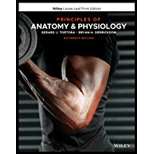
EBK PRINCIPLES OF ANATOMY AND PHYSIOLOG
16th Edition
ISBN: 9781119662686
Author: DERRICKSON
Publisher: VST
expand_more
expand_more
format_list_bulleted
Concept explainers
Question
Chapter 21, Problem 38CP
Summary Introduction
To review:
The physiology and anatomy of fetal circulation and the functions of foramen ovale, umbilical arteries, ductus arteriosus, umbilical vein, and ductus venosus.
Introduction:
The blood circulation that occurs in a fetus (unborn baby) is termed as fetal circulation. The special structures in fetal circulation enable developing embryo to exchange materials like nutrients with its mother.
Expert Solution & Answer
Want to see the full answer?
Check out a sample textbook solution
Students have asked these similar questions
Explain in a small summary how:
What genetic information can be obtained from a Punnet square? What genetic information cannot be determined from a Punnet square?
Why might a Punnet Square be beneficial to understanding genetics/inheritance?
In a small summary write down:
Not part of a graded assignment, from a past midterm
Chapter 21 Solutions
EBK PRINCIPLES OF ANATOMY AND PHYSIOLOG
Ch. 21 - Prob. 1CPCh. 21 - Prob. 2CPCh. 21 - Prob. 3CPCh. 21 - Prob. 4CPCh. 21 - Prob. 5CPCh. 21 - Prob. 6CPCh. 21 - Prob. 7CPCh. 21 - Prob. 8CPCh. 21 - Prob. 9CPCh. 21 - Prob. 10CP
Ch. 21 - Prob. 11CPCh. 21 - Prob. 12CPCh. 21 - Prob. 13CPCh. 21 - Prob. 14CPCh. 21 - Prob. 15CPCh. 21 - Prob. 16CPCh. 21 - Prob. 17CPCh. 21 - Prob. 18CPCh. 21 - Prob. 19CPCh. 21 - Prob. 20CPCh. 21 - Prob. 21CPCh. 21 - 22. Describe the types of shock and their causes...Ch. 21 - What is the purpose of systemic circulation?Ch. 21 - Prob. 24CPCh. 21 - Prob. 25CPCh. 21 - Prob. 26CPCh. 21 - Prob. 27CPCh. 21 - Prob. 28CPCh. 21 - Prob. 29CPCh. 21 - Prob. 30CPCh. 21 - Prob. 31CPCh. 21 - Prob. 32CPCh. 21 - Prob. 33CPCh. 21 - Prob. 34CPCh. 21 - Prob. 35CPCh. 21 - Prob. 36CPCh. 21 - Prob. 37CPCh. 21 - Prob. 38CPCh. 21 - Prob. 39CPCh. 21 - Prob. 40CPCh. 21 - 1. Kim Sung was told that her baby was born with a...Ch. 21 - 2. Michael was brought into the emergency room...Ch. 21 - Prob. 3CTQ
Knowledge Booster
Learn more about
Need a deep-dive on the concept behind this application? Look no further. Learn more about this topic, biology and related others by exploring similar questions and additional content below.Similar questions
- Noggin mutation: The mouse, one of the phenotypic consequences of Noggin mutationis mispatterning of the spinal cord, in the posterior region of the mouse embryo, suchthat in the hindlimb region the more ventral fates are lost, and the dorsal Pax3 domain isexpanded. (this experiment is not in the lectures).a. Hypothesis for why: What would be your hypothesis for why the ventral fatesare lost and dorsal fates expanded? Include in your answer the words notochord,BMP, SHH and either (or both of) surface ectoderm or lateral plate mesodermarrow_forwardNot part of a graded assignment, from a past midtermarrow_forwardNot part of a graded assignment, from a past midtermarrow_forward
- please helparrow_forwardWhat does the heavy dark line along collecting duct tell us about water reabsorption in this individual at this time? What does the heavy dark line along collecting duct tell us about ADH secretion in this individual at this time?arrow_forwardBiology grade 10 study guidearrow_forward
arrow_back_ios
SEE MORE QUESTIONS
arrow_forward_ios
Recommended textbooks for you
- Surgical Tech For Surgical Tech Pos CareHealth & NutritionISBN:9781337648868Author:AssociationPublisher:Cengage
 Principles Of Radiographic Imaging: An Art And A ...Health & NutritionISBN:9781337711067Author:Richard R. Carlton, Arlene M. Adler, Vesna BalacPublisher:Cengage Learning
Principles Of Radiographic Imaging: An Art And A ...Health & NutritionISBN:9781337711067Author:Richard R. Carlton, Arlene M. Adler, Vesna BalacPublisher:Cengage Learning  Human Physiology: From Cells to Systems (MindTap ...BiologyISBN:9781285866932Author:Lauralee SherwoodPublisher:Cengage Learning
Human Physiology: From Cells to Systems (MindTap ...BiologyISBN:9781285866932Author:Lauralee SherwoodPublisher:Cengage Learning Anatomy & PhysiologyBiologyISBN:9781938168130Author:Kelly A. Young, James A. Wise, Peter DeSaix, Dean H. Kruse, Brandon Poe, Eddie Johnson, Jody E. Johnson, Oksana Korol, J. Gordon Betts, Mark WomblePublisher:OpenStax College
Anatomy & PhysiologyBiologyISBN:9781938168130Author:Kelly A. Young, James A. Wise, Peter DeSaix, Dean H. Kruse, Brandon Poe, Eddie Johnson, Jody E. Johnson, Oksana Korol, J. Gordon Betts, Mark WomblePublisher:OpenStax College

Surgical Tech For Surgical Tech Pos Care
Health & Nutrition
ISBN:9781337648868
Author:Association
Publisher:Cengage

Principles Of Radiographic Imaging: An Art And A ...
Health & Nutrition
ISBN:9781337711067
Author:Richard R. Carlton, Arlene M. Adler, Vesna Balac
Publisher:Cengage Learning



Human Physiology: From Cells to Systems (MindTap ...
Biology
ISBN:9781285866932
Author:Lauralee Sherwood
Publisher:Cengage Learning

Anatomy & Physiology
Biology
ISBN:9781938168130
Author:Kelly A. Young, James A. Wise, Peter DeSaix, Dean H. Kruse, Brandon Poe, Eddie Johnson, Jody E. Johnson, Oksana Korol, J. Gordon Betts, Mark Womble
Publisher:OpenStax College